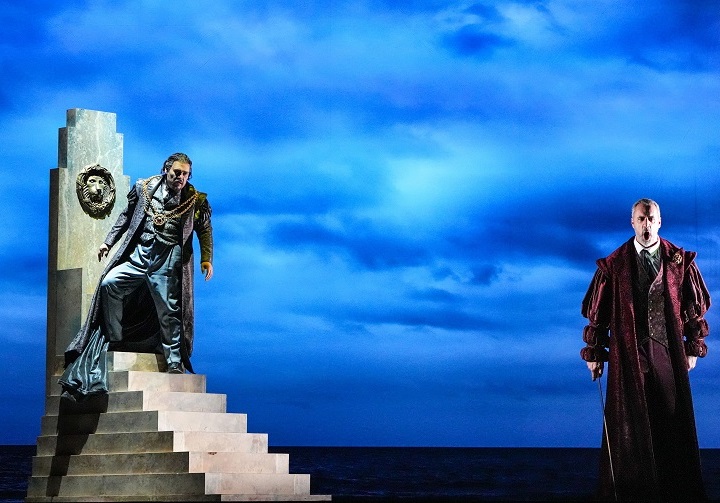Dueling fathers rule “Boccanegra” in Philadelphia’s wide-ranging fall festival

Quinn Kelsey (left) and Christian Van Horn in Verdi’s Simon Boccanegra at Opera Philadelphia. Photo: Steven Pisano
Opera Philadelphia’s Festival O23 continued Friday night with the premiere of a rewarding revival of Verdi’s Simon Boccanegra at the Academy of Music, with Quinn Kelsey in the title role. A failure with audiences at its premiere in 1857, the work had a special place in Verdi’s heart. He revisited it decades later in 1881, working with Boito (librettist of his great final works) to add the epic council chamber scene to the end of Act 1, now the great centerpiece of the regularly performed version. A potent story of political and familial intrigue surrounding a 14th-century Doge of Genoa, the opera’s themes and gloomy affect point to subsequent works like Don Carlo.
The special quality that Quinn Kelsey brings to Verdi’s signature baritone roles needs little introduction at this point. He was in complete command of the stage here, fully inhabiting Boccanegra’s many facets, from loving father to voluble autocrat to rueful old man. Verdi compresses so much life into this character, often in the same scene, and it is gripping to watch Kelsey seamlessly transition from volcanic rage to heartfelt call to peace while maintaining equivalent vocal intensity and commitment. Kelsey’s introspective and finely shaded singing through Boccanegra’s extended death sequence (a conveniently slow-acting poison) made for a particularly poignant final act.
Yet Kelsey’s performance may have shone brightest when he was opposite the Fiesco of Christian Van Horn. The bass-baritone brought an immediate authority and uncommon degree of nuance to Fiesco’s music, painting a memorable portrait of the vengeful patrician sworn against Boccanegra. The combination of Van Horn and Kelsey in the two great scenes that bookend the opera were the evening’s highlights, the explosive prologue confrontation and mournful Act III reconciliation finding the singers playing off each other with an exciting common focus.
As Boccanegra’s long-lost daughter Amelia and her rebel lover Gabriele Adorno, Ana María Martínez and Richard Trey Smagur could not quite match the intensity of the warring dads. If nothing else, an Amelia must deliver on the sparkling lines that cut through the low-voice heavy ensembles, and Martinez succeeded ably, her dark-hued soprano blossoming into a beautifully focused top (though her exposed trill in the council chamber scene ensemble was marred by a nightmare-level cell phone interruption). Amelia’s only extended solo statement, the sublime “Come in quest’ora bruna,” is one of Verdi’s pitiless cold open arias, and Martínez struggled a bit to make a coherent whole of it. Though she found her form for a confident and touching reunion scene opposite Kelsey, this was a highlight in a generally cautious performance.
Richard Trey Smagur’s imposing sound brings together many of the right qualities for a robust Verdi tenor, if lacking some final measure of brilliance. His energy level seemed inconsistent in his early scenes with Amelia and Fiesco, but he located an exciting new gear for Gabriele’s fiery exchanges in the close of Acts I and II. Gabriele’s aria “Sento avvampar nell’anima” was less successful, with Smagur unable to reign in that big sound and find more subtle effects, resulting in some ungainly moments there and in other more delicate tasks like the subsequent trio with Amelia and Boccanegra.
Elsewhere in the cast, Benjamin Taylor engaged in some delightful scenery-chewing as Paolo, the proto-Iago character whose malice drives the plot and who ultimately poisons Boccanegra, offering a formidable baritone in Paolo’s outbursts though missing some heft in the part’s lower reaches. Bass-baritone Cory McGee contributed a pleasingly large sound for Paolo’s accomplice, Pietro.
The overall musical success of the evening was due in no small measure to the leadership of Corrado Rovaris, who engaged the Opera Philadelphia musicians in a vivid reading of Verdi’s score. Rovaris excelled at lending just the right amount of weight to the orchestra in smaller scenes, bringing forward the score at key moments to complement the singers and enhance the drama, for instance, in the low string lines that undergird Boccanegra and Fiesco’s final scene. Explosive moments were uniformly enhanced by injections of energy from the pit, though Rovaris brought out gentler textures like the opening to the prologue and Act I as well.
Handling of the complete ensemble in moments like the chamber council scene was excellent, with Rovaris carefully marshalling dynamic and tempi changes from the responsive players to build to an exciting climax. Clarity and excitement in the substantial choral parts (prepared by Elizabeth Braden) further added to the impact of these sequences.
The handsome production, imported from the Opéra Royal de Wallonie in Liège with sets by Gary McCann, depicts a monumental, perhaps vaguely fascist Genoa, while attractive costumes (by Fernand Ruiz) combine elements of modern dress with extravagant period details. There isn’t much more to the concept, but it makes for some grand-looking pictures on the Academy of Music stage. Direction by Laurence Dale kept the action moving in the crowd sequences, though handling of the principals could be static at times.
Simon Boccanegra runs through October 1. operaphila.org

Posted Sep 24, 2023 at 2:36 pm by Beatriz Pena
I loved the scene of Fiesco and Adorno where Fiesco, Amelia’s guardian, in actuality her biological grandfather, unbeknownst to him in this particular moment grants Adorno her hand in marriage. Sung like a sacred oath with such beauty and majesty by Mr. Van Horn and Mr Saguri. Hair-raising cannot leave my mind¡